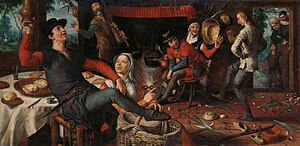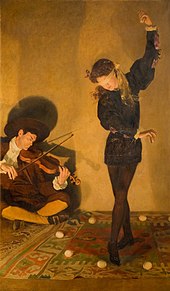Egg dance
A hundred eggs were scattered over a level space covered with sand, and a young couple, taking hands, began the dance.
After three couples had failed, midst the laughter and shouts of derision of the on-lookers, Philibert of Savoy, bending on his knee before Marguerite, begged her consent to try the dance with him.
[7] The 1867 book The Sports and Pastimes of the People of England reads:[8] The indication of such a performance occurs in an old comedy, entitled The longer thou livest, the more Foole thou art, by William Wager in the reign of Queen Elizabeth, where we meet with these lines: Upon my one foote pretely I can hoppe.And daunce it trimley about an egge.Dancing upon one foot was exhibited by the Saxon gleemen, and probably by the Norman minstrels, but more especially by the women-dancers, who might thence acquire the name of hoppesteres,[9] which is given by Chaucer.
In his Proverbs printed in 1566, are the following lines: Where wooers hoppe in and out, long time may bringHim that hoppeth best at last to have the ring But to return to the egg-dance.
[10] Julian Mates in his book The American Stage before 1800 notes that blindfolded egg dances were a popular musical act both in Europe and the United States during the 18th century.

